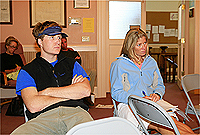Land north of Pero Road in the Bellevue Triangle is an appropriate location for increased density and should be a designated transfer of development rights (TDR) receiving area, the Blaine County Commission decided earlier this week in one of three 2025 public hearings.
The decision gels with the original proposal from Clarion Associates, a land-use consultant hired by the county to help draft the 2025 ordinances, but counters advice from the Planning and Zoning Commission.
In April, the P&Z Commission agreed that designating land north of Pero Road as a receiving area would be inappropriate since it's dotted with wildlife migration corridors and winter feeding grounds, and it is considered too far south of Bellevue city limits. The latter sparked concerns that developing that far from city limits would contradict the county's comprehensive plan.
But County Commissioner Tom Bowman felt that moving forward without a designated TDR receiving area—the area north of Pero Road is the only one considered at this point—puts the entire program at risk.
Bowman also said it would be a "show of good faith to the cities" to designate a receiving area in the unincorporated county.
Over the past couple months the cities have been under significant pressure to participate in the county's TDR program, which aims to discourage development in the remote areas of the county while focusing it in and around the cities.
Ketchum and Hailey city officials initially expressed resentment that they were being looked at as the scapegoats for the county's development pressures.
But on Tuesday Bowman said a Hailey city official had contacted the county and was eager to meet to discuss the TDR program. Bellevue, meanwhile, has already come on board. In May, Bowman and Blaine County Planner Jeff Adams met with Bellevue city officials, who agreed to collaborate on the TDR program.
Bowman reiterated that establishing a TDR receiving area north of Pero Road was just a start, and that identifying other potential receiving areas "needs more work once the moratorium expires."
The county commissioners managed to plow through all four ordinances in three separate hearings Tuesday, Wednesday and Thursday. Following are some of the key discussion points:
· TDR sending areas: Property owners in the southern areas of the Bellevue Triangle near Silver Creek, which is the designated sending area for the TDR program since it's peppered with wetlands, will be able to maintain more development rights.
The county commissioners have decided to allow people whose land is fractured by wetlands but who don't participate in the TDR program to focus density on the dry areas of their property. Previously, non-participants would not be granted any density rights.
· City spheres: The commissioners decided to keep the three-mile spheres around the cities of Ketchum, Sun Valley, Hailey and Bellevue, but to limit the circles around Carey to one-mile and Gannett to a quarter mile. Picabo, however, was upgraded to a one-mile sphere. All land inside those spheres will retain their current zoning, while lands outside the area will be downzoned to A40. Lands north of Baseline Road will be zoned A20.
· Cluster Developments: Per the county commissioner's advice, Clarion Associates rewrote part of this ordinance to allow larger cluster developments where appropriate. The maximum number of lots in a single cluster tract will remain at five, but could be increased to 20 if the proposal meets a series of high environmental standards. Also, cluster developments will be prohibited in areas greater than one-mile distance from a paved and plowed road.
· Planned Unit Developments (PUD's): These dense developments will only be allowed inside the city spheres and on land zoned R10 or lower. PUD developments in areas zoned R2.5 acres or less must include 20 percent open space, while PUD's in R5 areas and larger must devote 50 percent to open space.
· Wetlands: These sensitive lands spark equally sensitive debate, but will be addressed by the P&Z commission later this month.
· Family Parcels: Greg Van Der Muelen, who grew up working on his dad's ranch near Glendale Road, introduced this proposal—to allow immediate family members to subdivide and build homes on their parent's property—during the first hearing May 25. It's since been a discussion item in every hearing.
On Tuesday the commissioners applauded Van Der Muelen for his effort and recommended that his proposal be passed down to the P&Z Commission and reviewed as a separate ordinance. Van Der Muelen, 26, said he received assistance on his proposal from fifth generation Blaine County residents and sisters Sarah Gardner and Julie Cord, Community School teacher Ryan Waterfield, and Chris Duerksen, of Clarion Associates.
Commissioner Dennis Wright said that enduring the time to create a separate ordinance for a family lot split would pay off in the long run.
"In the land-use arena, the reason the process is so important is because all you have to do is miss a step for it to be appealed," Wright said. "Then it will be over there in the courthouse, and everything will stop."


 A Family Parcels ordinance proposed by Greg Van Der Muelen and Ryan Waterfield would allow immediate family members to subdivide and build homes on their parent's property. Photo by David N. Seelig
A Family Parcels ordinance proposed by Greg Van Der Muelen and Ryan Waterfield would allow immediate family members to subdivide and build homes on their parent's property. Photo by David N. Seelig



































